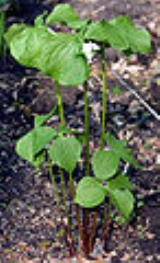
Trillium cernuum
Encyclopedia
Trillium cernuum is a species of Trillium
native to northeastern North America
, from Newfoundland west to southern Saskatchewan
, and south to northern Virginia
and Iowa
. It occurs on rich, moist soils in both broadleaf and coniferous woodland.
It is a perennial
herbaceous plant
with one or more unbranched stems 15–60 cm tall growing from an underground rhizome
. The apex of each stem has whorl of three abruptly pointed bracts 4–15 cm long and 6–18 cm broad, and on strong stems, also a solitary flower
hanging below the leaves on a 0.5–3.5 cm peduncle
. The flower is perfect
, with three slender pale green sepal
s 9–30 mm long, three broad white (rarely pink) petal
s 15–25 mm long and 5–15 mm broad, six purple stamen
s, and a solitary pistil; flowering is in late spring to early summer. The fruit
is a six-lobed reddish berry
up to 3 cm diameter, ripening in late summer.
Trillium
Trillium is a genus of about 40–50 species of spring ephemeral perennials, native to temperate regions of North America and Asia....
native to northeastern North America
North America
North America is a continent wholly within the Northern Hemisphere and almost wholly within the Western Hemisphere. It is also considered a northern subcontinent of the Americas...
, from Newfoundland west to southern Saskatchewan
Saskatchewan
Saskatchewan is a prairie province in Canada, which has an area of . Saskatchewan is bordered on the west by Alberta, on the north by the Northwest Territories, on the east by Manitoba, and on the south by the U.S. states of Montana and North Dakota....
, and south to northern Virginia
Virginia
The Commonwealth of Virginia , is a U.S. state on the Atlantic Coast of the Southern United States. Virginia is nicknamed the "Old Dominion" and sometimes the "Mother of Presidents" after the eight U.S. presidents born there...
and Iowa
Iowa
Iowa is a state located in the Midwestern United States, an area often referred to as the "American Heartland". It derives its name from the Ioway people, one of the many American Indian tribes that occupied the state at the time of European exploration. Iowa was a part of the French colony of New...
. It occurs on rich, moist soils in both broadleaf and coniferous woodland.
It is a perennial
Perennial plant
A perennial plant or simply perennial is a plant that lives for more than two years. The term is often used to differentiate a plant from shorter lived annuals and biennials. The term is sometimes misused by commercial gardeners or horticulturalists to describe only herbaceous perennials...
herbaceous plant
Herbaceous plant
A herbaceous plant is a plant that has leaves and stems that die down at the end of the growing season to the soil level. They have no persistent woody stem above ground...
with one or more unbranched stems 15–60 cm tall growing from an underground rhizome
Rhizome
In botany and dendrology, a rhizome is a characteristically horizontal stem of a plant that is usually found underground, often sending out roots and shoots from its nodes...
. The apex of each stem has whorl of three abruptly pointed bracts 4–15 cm long and 6–18 cm broad, and on strong stems, also a solitary flower
Flower
A flower, sometimes known as a bloom or blossom, is the reproductive structure found in flowering plants . The biological function of a flower is to effect reproduction, usually by providing a mechanism for the union of sperm with eggs...
hanging below the leaves on a 0.5–3.5 cm peduncle
Peduncle (botany)
In botany, a peduncle is a stem supporting an inflorescence, or after fecundation, an infructescence.The peduncle is a stem, usually green and without leaves, though sometimes colored or supporting small leaves...
. The flower is perfect
Plant sexuality
Plant sexuality covers the wide variety of sexual reproduction systems found across the plant kingdom. This article describes morphological aspects of sexual reproduction of plants....
, with three slender pale green sepal
Sepal
A sepal is a part of the flower of angiosperms . Collectively the sepals form the calyx, which is the outermost whorl of parts that form a flower. Usually green, sepals have the typical function of protecting the petals when the flower is in bud...
s 9–30 mm long, three broad white (rarely pink) petal
Petal
Petals are modified leaves that surround the reproductive parts of flowers. They often are brightly colored or unusually shaped to attract pollinators. Together, all of the petals of a flower are called a corolla. Petals are usually accompanied by another set of special leaves called sepals lying...
s 15–25 mm long and 5–15 mm broad, six purple stamen
Stamen
The stamen is the pollen producing reproductive organ of a flower...
s, and a solitary pistil; flowering is in late spring to early summer. The fruit
Fruit
In broad terms, a fruit is a structure of a plant that contains its seeds.The term has different meanings dependent on context. In non-technical usage, such as food preparation, fruit normally means the fleshy seed-associated structures of certain plants that are sweet and edible in the raw state,...
is a six-lobed reddish berry
Berry
The botanical definition of a berry is a fleshy fruit produced from a single ovary. Grapes are an example. The berry is the most common type of fleshy fruit in which the entire ovary wall ripens into an edible pericarp. They may have one or more carpels with a thin covering and fleshy interiors....
up to 3 cm diameter, ripening in late summer.
External links
- Profile: Nodding Trillium (Trillium cernuum) Photos, Drawings, Text. (Wild Plants of Winnipeg from Nature Manitoba)

